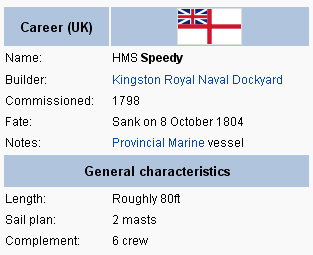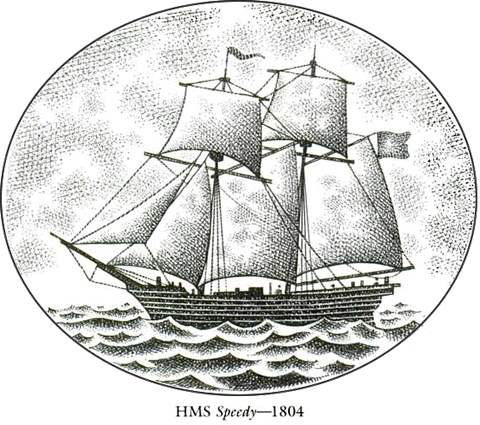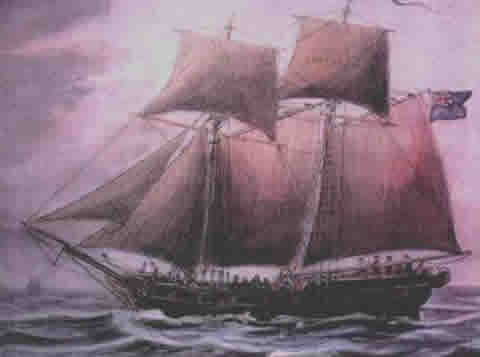
"In Beautiful
Brighton, Ontario"

HMS Speedy (1798)
History

HMS Speedy was one of five warships rushed into service, quickly built from green timber at Cataraqui in 1798, to help defend British Upper Canada from the perceived threat from the newly formed United States of America. That threat was later realised as the War of 1812, but Speedy would not survive to see service in that conflict. Speedy carried four-pound guns and had a 55 foot, two-masted hull plus a 20+ foot bowsprit, bringing her close to 80 feet in total length. In spite of her name, Speedy was considered quite slow for her era. Because she was constructed from improperly seasoned green timber, she almost immediately began to suffer problems with leaks and dry rot after her commissioning.
Final Journey
The schooner left York on 7 October 1804 at the insistence of autocratic Lieutenant-Governor Peter Hunter, despite the reluctance of the ship's captain, Lieutenant Thomas Paxton. Paxton, an experienced British Naval officer, was concerned about an incoming storm and the condition of the ship.
Although only six years old, Speedy suffered from extensive weakening of the hull from dry rot due to the timber used in her rushed construction. Two of Speedy's crew were required to constantly operate manual bilge pumps in order to keep her afloat for the journey. Under threat of court martial, Paxton departed. Almost immediately upon her launch, she ran aground in the harbour due to the heavy load she was carrying, resulting in a six hour delay.

After freeing herself, she sailed due east - this on the evening of October 7 - Speedy stopped briefly at Port Oshawa to pick up the Farewell brothers who were business partners of the murder victim and key witnesses for the prosecution, a handful of natives who were also to provide testimony. Interestingly the Farewell brothers refused to board the ship, expressing concern that it was already overloaded, crowded, and unsafe. They elected to accompany Speedy in a canoe.
Speedy and the canoe were separated as the storm deteriorated into blizzard conditions during the afternoon and evening of 8 October. The wind had turned and was blowing out of the north-east. By the morning of 9 October, the brothers managed to reach Newcastle's harbour, not so for the Speedy. Soon the schooner was sighted passing Presqu'ile Point at dusk on the 8th. The crew fired one of her cannons to signal her situation and position. In response; shoreline bonfires were lit ostensibly to guide her to safety.
Unfortunately, the schooner vanished on approach to the mouth of the bay. All that was found of the ship, her passengers, cargo, and six-man crew were a chicken coop and compass box. These washed up on the beach opposite the bay.
This inspired a great deal of speculation about her fate. Theories ranged from sabotage by parties wishing to prevent the establishment of new fledgling provincial capital of Newcastle, to those promoting a supernatural hypothesis - one of alien abduction ultimately - the ship having effectively been scooped off the face of the earth by parties unknown.
Disaster

Evidence suggests that Speedy, unaware that she was in the area now known as the Sophiasburgh Triangle, where poorly quantified magnetic anomalies purportedly exist and prevent proper compass operation, and unable to sail directly into the north-easterly wind because she was a square-rigger, tacked across the mouth of Presqu'ile Bay to avoid Bald Head Island and angle her way into port. Unable to navigate using celestial markers or spot the signal fires due to the storm-induced white outs, the captain was completely reliant on the ship's compass to navigate and struck the mysterious Devil's Horseblock (or Hitching Post), a stone column (pinnacle) that extended up from depths unknown to within a mere 20 cm of the surface.
The area was dragged with hooks in a government-sponsored effort to establish what had actually transpired. It was established that the mysterious monolithic Horseblock shoal had also vanished. Some suggested the 200-ton Speedy was capable of up-ending - of toppling over this unusual formation.
Speedy became the latest of nearly 100 ships The Sophiasburgh Triangle had claimed since the beginning of the 18th century, adding to fears that the area was too dangerous for a major port.
Aftermath
In part due to this disaster, Presqu'ile was deemed an inappropriate and "inconvenient" location for a district town. The incident was called "a disaster felt by the Bench, the Bar, Society, the Legislature and the Country." [1] Newcastle was abandoned and the district centre was moved to Amherst (now known as Cobourg, Ontario) in 1805.
In addition to the accused, many of the souls lost with disappearance of the Speedy were prominent United Empire Loyalists, government officials and important members of the small colony.
The disaster likely changed the course of Canadian history, as it was believed that the new capital of the colony would be moved to Newcastle once the town was established. Those plans were abandoned due to the sudden loss of so many significant members of Upper Canada society.
References:
Wikipedia - The Free Encyclopedia
